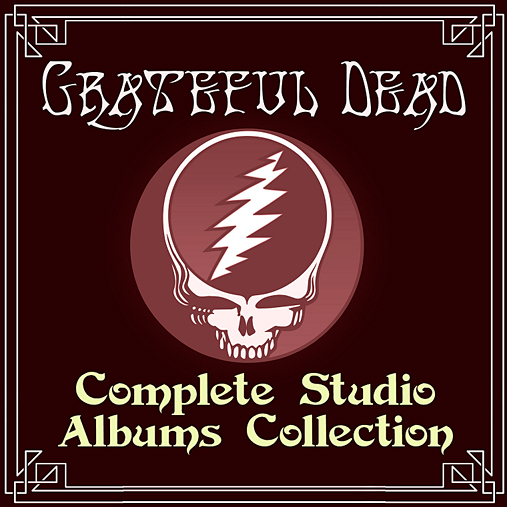
Grateful Dead – Complete Studio Albums Collection (2013)
FLAC (tracks) 24 bit/192 kHz | Time – 521:14 minutes | 19,4 GB
Official Digital Download – Source: HDTracks.com | Front covers
13 Studio albums: 1967-89 > Newest re-mastering from the Original master tapes
This new hi-res collection of the Grateful Dead’s studio work has been painstakingly produced from the original master tapes of each album, using their original mixes to produce a work that is truer to the original sound than any previous release. Included in this collection are the band’s 13 studio albums, spanning three decades and containing over 8 hours of music, lovingly rendered in hi-resolution…
The Complete Studio Albums Collection contains all 13 of Grateful Dead’s studio albums. Drawing from the 1960s, the bundle features the group’s gold-certified self-titled debut; Anthem of the Sun, which is the first with drummer Mickey Hart; and Aoxomoxoa, which boasts the live staple “St. Stephen.” Music from the 1970s includes: the back-to-back platinum releases Workingman’s Dead and American Beauty; Wake Of The Flood, the first with keyboardist Keith Godchaux who replaced founding member Ron “Pigpen” McKernan; From the Mars Hotel, which features the debut of “Scarlet Begonias”; Blues For Allah with the standout track “Franklin’s Tower”; and two gold albums in a row, Terrapin Station and Shakedown Street. The 1980s are represented by: Go To Heaven, the first with keyboardist Brent Mydland; the double-platinum In The Dark; and the group’s final studio album, Built To Last, which debuted on Halloween 1989.
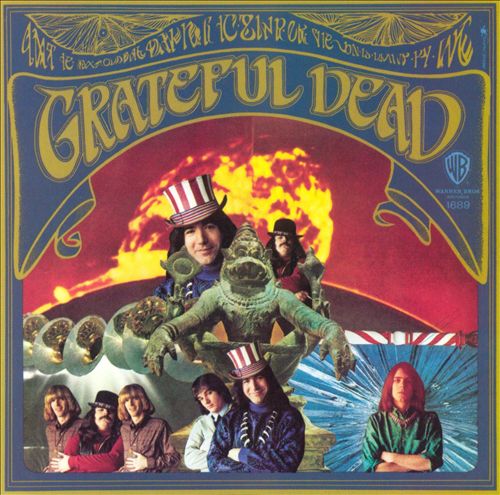
Grateful Dead – The Grateful Dead (1967/2013)
FLAC (tracks) 24 bit/192 kHz | Time – 35:51 minutes | 1,52 GB
Official Digital Download – Source: HDTracks.com | Front cover
The Grateful Dead’s eponymously titled debut long-player was issued in mid-March of 1967. This gave rise to one immediate impediment — the difficulty in attempting to encapsulate/recreate the Dead’s often improvised musical magic onto a single LP. Unfortunately, the sterile environs of the recording studio disregards the subtle and often not-so-subtle ebbs and zeniths that are so evident within a live experience. So, while this studio recording ultimately fails in accurately exhibiting The Grateful Dead’s tremendous range, it’s a valiant attempt to corral the group’s hydra-headed psychedelic jug-band music on vinyl. Under the technical direction of Dave Hassinger — who had produced the Rolling Stones as well as the Jefferson Airplane — the Dead recorded the album in Los Angeles during a Ritalin-fuelled “long weekend” in early 1967. Rather than prepare all new material for the recording sessions, a vast majority of the disc is comprised of titles that the band had worked into their concurrent performance repertoire. This accounts for the unusually high ratio (seven:two) of folk and blues standards to original compositions. The entire group took credit for the slightly saccharine “Golden Road (To Unlimited Devotion),” while Jerry Garcia (guitar/vocals) is credited for the noir garage-flavored raver “Cream Puff War.” Interestingly, both tracks were featured as the respective A- and B-sides of the only 45 rpm single derived from this album. The curious aggregate of cover tunes featured on the Dead’s initial outing also demonstrates the band’s wide-ranging musical roots and influences. These include Pigpen’s greasy harp-fuelled take on Sonny Boy Williamson’s “Good Morning Little School Girl” and the minstrel one-man-band folk of Jessie “the Lone Cat” Fuller’s “Beat It On Down the Line.” The apocalyptic Cold War folk anthem “Morning Dew” (aka “[Walk Me Out in The] Morning Dew”) is likewise given a full-bodied electric workout as is the obscure jug-band stomper “Viola Lee Blues.” Fittingly, the Dead would continue to play well over half of these tracks in concert for the next 27 years.
Tracklist:
01 – The Golden Road (To Unlimited Devotion)
02 – Beat It On Down The Line
03 – Good Morning Little School Girl
04 – Cold Rain And Snow
05 – Sitting On Top Of The World
06 – Cream Puff War
07 – Morning Dew
08 – New New Minglewood Blues
09 – Viola Lee Blues
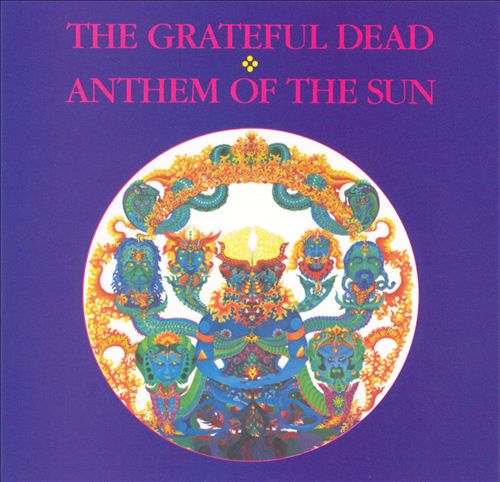
Grateful Dead – Anthem Of The Sun (1968/2013)
FLAC (tracks) 24 bit/192 kHz | Time – 38:57 minutes | 1,48 GB
Official Digital Download – Source: HDTracks.com | Front cover
As the second long-player by the Grateful Dead, Anthem of the Sun (1968) pushed the limits of both the music as well as the medium. General dissatisfaction with their self-titled debut necessitated the search for a methodology to seamlessly juxtapose the more inspired segments of their live performances with the necessary conventions of a single LP. Since issuing their first album, the Dead welcomed lyricist Robert Hunter into the fold — freeing the performing members to focus on the execution and taking the music to the next level. Another addition was second percussionist Mickey Hart, whose methodical timekeeping would become a staple in the Dead’s ability to stop on the proverbial rhythmic dime. Likewise, Tom Constanten (keyboards) added an avant-garde twist to the proceedings with various sonic enhancements that were more akin to John Cage and Karlheinz Stockhausen than anything else coming from the burgeoning Bay Area music scene. Their extended family also began to incorporate folks like Dan Healy — whose non-musical contributions and innovations ranged from concert PA amplification to meeting the technical challenges that the band presented off the road as well. On this record Healy’s involvement cannot be overstated, as the band were essentially given carte blanche and simultaneous on-the-job training with regards to the ins and outs of the still unfamiliar recording process. The idea to create an aural pastiche from numerous sources — often running simultaneously — was a radical concept that allowed consumers worldwide to experience a simulated Dead performance firsthand. One significant pattern which began developing saw the band continuing to refine the same material that they were concurrently playing live night after night prior to entering the studio. The extended “That’s It for the Other One” suite is nothing short of a psychedelic roller coaster. The wild ride weaves what begins as a typical song into several divergent performances — taken from tapes of live shows — ultimately returning to the home base upon occasion, presumably as a built-in reality check. Lyrically, Bob Weir (guitar/vocals) includes references to their 1967 pot bust (“…the heat came ’round and busted me for smiling on a cloudy day”) as well as the band’s spiritual figurehead Neal Cassidy (“…there was Cowboy Neal at the wheel on a bus to never ever land”). Although this version smokes from tip to smouldering tail, the piece truly developed a persona all its own and became a rip-roaring monster in concert. The tracks “New Potato Caboose” and Weir’s admittedly autobiographically titled “Born Cross-Eyed” are fascinatingly intricate side trips that had developed organically during the extended work’s on-stage performance life. “Alligator” is a no-nonsense Ron “Pigpen” McKernan workout that motors the second extended sonic collage on Anthem of the Sun. His straight-ahead driving blues ethos careens headlong into the Dead’s innate improvisational psychedelia. The results are uniformly brilliant as the band thrash and churn behind his rock-solid lead vocals. Musically, the Dead’s instrumental excursions wind in and out of the primary theme, ultimately ending up in the equally frenetic “Caution (Do Not Stop on Tracks).” Although the uninitiated might find the album unnervingly difficult to follow, it obliterated the pretension of the post-Sgt. Pepper’s “concept album” while reinventing the musical parameters of the 12″ LP medium.
Tracklist:
01 – That’s It For The Other One (Parts I-IV)
02 – New Potato Caboose
03 – Born Cross-Eyed
04 – Alligator
05 – Caution (Do Not Stop On The Tracks)
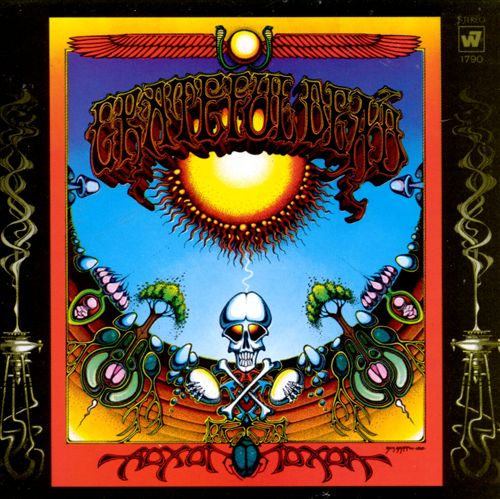
Grateful Dead – Aoxomoxoa (1969/2013)
FLAC (tracks) 24 bit/192 kHz | Time – 36:15 minutes | 1,4 GB
Official Digital Download – Source: HDTracks.com | Front cover
The Grateful Dead’s third studio effort was also the first that the band did without any Warner Bros. staff producers or engineers hampering their creative lifestyle and subsequent processes. As they had done with their previous release, Anthem of the Sun, the Dead were actively seeking new forays and pushing envelopes on several fronts simultaneously during Aoxomoxoa (1968) — which was created under the working title of “Earthquake Country.” This was no doubt bolstered by the serendipitous technological revolution which essentially allowed the Dead to re-record the entire contents when given free reign at the appropriately named Pacific High Recording facility. As fate would have it, they gained virtually unlimited access to the newly acquired Ampex MM-1000 — the very first 16-track tape machines ever produced — which was absolutely state of the art in late 1968. The band was also experiencing new directions artistically. This was primarily the net result of the budding relationship between primary (by default) melodic contributor Jerry Garcia (guitar/vocals) and Robert Hunter (lyrics), who began his nearly 30-year association with The Grateful Dead in earnest during these sessions. When the LP hit the racks in the early summer of 1969, Deadheads were greeted by some of the freshest and most innovative sounds to develop from the thriving Bay Area music scene. The disc includes seminal psychedelic rockers such as “St. Stephen,” “China Cat Sunflower,” and “Cosmic Charlie,” as well as hints of the acoustic direction their music would take on the Baroque-influenced “Mountains of the Moon” and “Rosemary.” The folky “Dupree’s Diamond Blues” — which itself was loosely based on the traditional “Betty & Dupree” — would likewise foreshadow the sound of their next two studio long-players, Workingman’s Dead (1969) and American Beauty (1970). The too-trippy-for-its-own-good “What’s Become of the Baby” is buried beneath layers of over-indulgence. This is unfortunate, as Hunter’s surreal lyrics and Garcia’s understated vocals languish beneath the soupy sonics. In 1972, Aoxomoxoa was overhauled, and the original mix — which includes several significant differences such as an a cappella vocal tag at the tail end of “Doin’ That Rag” — has yet to be reissued in any form.
Tracklist:
01 – St. Stephen
02 – Dupree’s Diamond Blues
03 – Rosemary
04 – Doin’ That Rag
05 – Mountains Of The Moon
06 – China Cat Sunflower
07 – What’s Become Of The Baby
08 – Cosmic Charlie

Grateful Dead – Workingman’s Dead (1970/2013)
FLAC (tracks) 24 bit/192 kHz | Time – 35:46 minutes | 1,83 GB
Official Digital Download – Source: HDTracks.com | Front cover
The Grateful Dead were already established as paragons of the free-form, improvisational San Francisco psychedelic sound when they abruptly shifted gears for the acoustic Workingman’s Dead, a lovely exploration of American roots music illuminating the group’s country, blues, and folk influences. The lilting “Uncle John’s Band,” their first radio hit, opens the record and perfectly summarizes its subtle, spare beauty; complete with a new focus on more concise songs and tighter arrangements, the approach works brilliantly. Despite its sharp contrast to the epic live space jams on which the group’s legend primarily rests, Workingman’s Dead nonetheless spotlights the Dead at their most engaging, stripped of all excess to reveal the true essence of their craft.
Tracklist:
01 – Uncle John’s Band
02 – High Time
03 – Dire Wolf
04 – New Speedway Boogie
05 – Cumberland Blues
06 – Black Peter
07 – Easy Wind
08 – Casey Jones
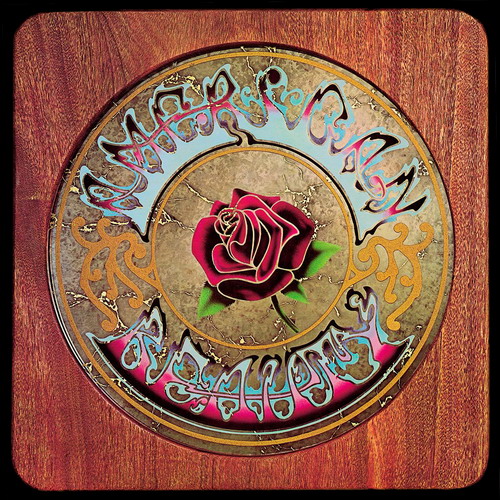
Grateful Dead – American Beauty (1970/2013)
FLAC (tracks) 24 bit/192 kHz | Time – 42:32 minutes | 1,45 GB
Official Digital Download – Source: HDTracks.com | Front cover
A companion piece to the luminous Workingman’s Dead, American Beauty is an even stronger document of the Grateful Dead’s return to their musical roots. Sporting a more full-bodied and intricate sound than its predecessor thanks to the addition of subtle electric textures, the record is also more representative of the group as a collective unit, allowing for stunning contributions from Phil Lesh (the poignant opener, “Box of Rain”) and Bob Weir (“Sugar Magnolia”); at the top of his game as well is Jerry Garcia, who delivers the superb “Friend of the Devil,” “Candyman,” and “Ripple.” Climaxing with the perennial “Truckin’,” American Beauty remains the Dead’s studio masterpiece — never again would they be so musically focused or so emotionally direct.
Tracklist:
01 – Box Of Rain
02 – Friend Of The Devil
03 – Sugar Magnolia
04 – Operator
05 – Candyman
06 – Ripple
07 – Brokedown Palace
08 – Till The Morning Comes
09 – Attics Of My Life
10 – Truckin’

Grateful Dead – Wake Of The Flood (1973/2013)
FLAC (tracks) 24 bit/192 kHz | Time – 45:25 minutes | 1,78 GB
Official Digital Download – Source: HDTracks.com | Front cover
After satisfying their nine-title/dozen-disc deal with Warner Brothers, the Dead began their own record labels: Grateful Dead Records (for group releases) and Round Records (for solo projects). Wake of the Flood was the first Dead disc issued entirely under the band’s supervision — which also included manufacturing and marketing. Additionally, the personnel had been altered as Ron “Pigpen” McKernan had passed away. The keyboard responsibilities were now in the capable hands of Keith Godchaux — whose wife Donna Jean Godchaux also provided backing vocals. It had been nearly three years since American Beauty — their previous and most successful studio album to date — and, as always, the Dead had been honing the material in concert. A majority of the tracks had been incorporated into their live sets — some for nearly six months — prior to entering the recording studio. This gave the band a unique perspective on the material, much of which remained for the next 20-plus years as staples of their concert performances. However, the inspiration and magic of the Grateful Dead’s music has always been a challenge to capture in the non-reciprocal confines of a studio. Therefore, while Wake of the Flood was certainly as good — if not arguably better than — most of their previous non-live efforts, it falls far short of the incendiary performances the band was giving during this era. There are a few tracks that do tap into some of the Dead’s jazzier and exceedingly improvisational nature. “Eyes of the World” contains some brilliant ensemble playing — although the time limitations inherent in the playback medium result in the track fading out just as the Dead start to really cook. Another highlight is Bob Weir’s “Weather Report Suite,” which foreshadows the epic proportions that the song would ultimately reach. In later years, the band dropped the opening instrumental “Prelude,” as well as “Part One,” choosing to pick it up for the extended “Let It Grow” section. The lilting Jerry Garcia ballad “Stella Blue” is another track that works well in this incarnation and remained in the Dead’s rotating set list for the remainder of their touring careers.
Tracklist:
01 – Mississippi Half-Step Uptown Toodeloo
02 – Let Me Sing Your Blues Away
03 – Row Jimmy
04 – Stella Blue
05 – Here Comes Sunshine
06 – Eyes Of The World
07 – Weather Report Suite
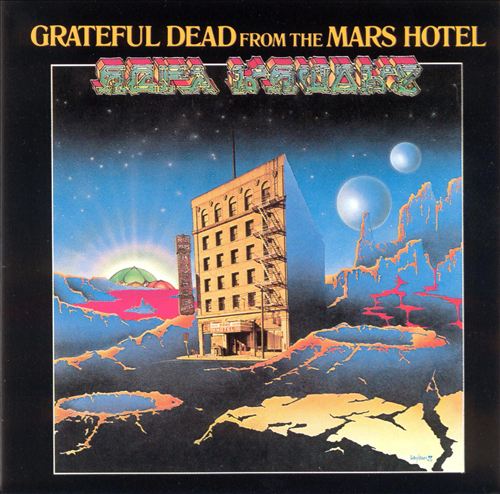
Grateful Dead – From The Mars Hotel (1974/2013)
FLAC (tracks) 24 bit/192 kHz | Time – 37:33 minutes | 1,5 GB
Official Digital Download – Source: HDTracks.com | Front cover
The Grateful Dead made their reputation on the road with their live shows, and they always struggled to capture that magic in the studio. From the Mars Hotel, while not a classic, represents one of their better studio albums. Jerry Garcia sounds engaged throughout and takes the vocal reigns for most of the songs on the album — although he’s not the most gifted vocalist, he proves himself able and versatile. He sings the rollicking opener, “U.S. Blues,” with a tongue-in-cheek seriousness that gives the political song an edge, and he lends emotional sincerity to the atmospheric ballad “China Doll.” Garcia shines on guitar during the funk workout “Scarlet Begonias,” but the ensemble work is best displayed on the album’s centerpiece, “Unbroken Chain.” During this song, all the musicians are allowed to shine: Phil Lesh, the bassist and songwriter, provides tender vocals over a piano-based arrangement while the bridge allows the guitars and drums to stretch out in classic Grateful Dead style. This album is highly recommended for fans, but casual listeners should start with American Beauty or Workingman’s Dead.
Tracklist:
01 – U.S. Blues
02 – China Doll
03 – Unbroken Chain
04 – Loose Lucy
05 – Scarlet Begonias
06 – Pride Of Cucamonga
07 – Money Money
08 – Ship Of Fools
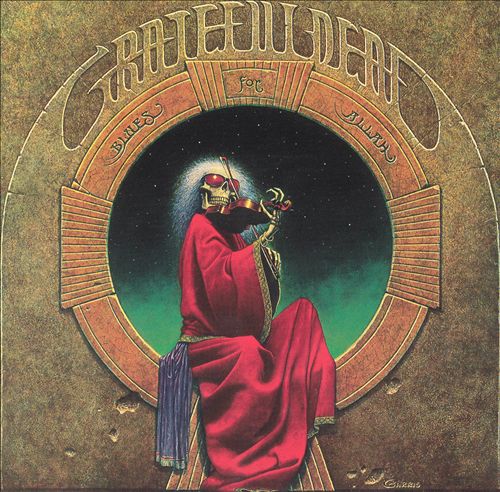
Grateful Dead – Blues For Allah (1975/2013)
FLAC (tracks) 24 bit/192 kHz | Time – 44:12 minutes | 1,77 GB
Official Digital Download – Source: HDTracks.com | Front cover
The Grateful Dead went into a state of latent activity in the fall of 1974 that lasted until the spring of the following year when the band reconvened at guitarist/vocalist Bob Weir’s Ace Studios to record Blues for Allah. The disc was likewise the third to be issued on their own Grateful Dead Records label. When the LP hit shelves in September of 1975, the Dead were still not back on the road — although they had played a few gigs throughout San Francisco. Obviously, the time off had done the band worlds of good, as Blues for Allah — more than any past or future studio album — captures the Dead at their most natural and inspired. The opening combo of “Help on the Way,” “Slipknot!,” and “Franklin’s Tower” is a multifaceted suite, owing as much to Miles Davis circa the E.S.P. album as to anything The Grateful Dead had been associated with. “Slipknot!” contains chord changes, progressions, and time signatures which become musical riddles for the band to solve — which they do in the form of “Franklin’s Tower.” Another highly evolved piece is the rarely performed “King Solomon’s Marbles,” an instrumental that spotlights, among other things, Keith Godchaux’s tastefully unrestrained Fender Rhodes finger work displaying more than just a tinge of Herbie Hancock inspiration. These more aggressive works contrast the delicate musical and lyrical haiku on “Crazy Fingers” containing some of lyricist Robert Hunter’s finest and most beautifully arranged verbal images for the band. Weir’s guitar solo in “Sage & Spirit” is based on one of his warm-up fingering exercises. Without a doubt, this is one of Weir’s finest moments. The light acoustic melody is tinged with an equally beautiful arrangement. While there is definite merit in Blues for Allah’s title suite, the subdued chant-like vocals and meandering melody seems incongruous when compared to the remainder of this thoroughly solid effort.
Tracklist:
01 – Help On The Way / Slipknot!
02 – Franklin’s Tower
03 – King Solomon’s Marbles
04 – The Music Never Stopped
05 – Crazy Fingers
06 – Sage & Spirit
07 – Blues For Allah: Sand Castles And Glass Camels / Unusual Occurrences In The Desert
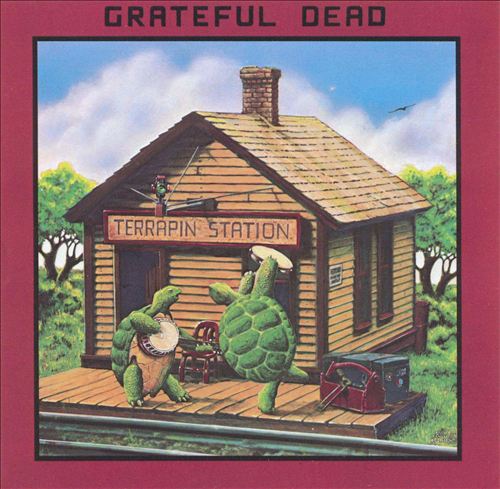
Grateful Dead – Terrapin Station (1977/2013)
FLAC (tracks) 24 bit/192 kHz | Time – 35:40 minutes | 1,41 GB
Official Digital Download – Source: HDTracks.com | Front cover
It is generally agreed that the Grateful Dead’s late-’70s studio releases left even the most enthusiastic Deadheads longing for something more. The theory is that the band’s momentum is best experienced during the ebb and flow of a live performance rather than the somewhat clinical tedium of a recording studio. Terrapin Station marks several milestones for the Grateful Dead: it was the band’s first studio album in two years, as well as their return to a major label — in this case Arista Records. More significant however is the use of an outside (read: non-Grateful Dead) producer. This was only the second time in which the Dead did not seize complete control. And the first time in a decade that they would relinquish their production reigns. They chose Keith Olsen — a former member of the ’60s garage rock band Music Machine — whose production roster also included other Bay Area notables including the Sons of Champlin and Santana. Musically, Terrapin Station offers a few choice glimpses of the band doing what it does best. While the most prominent example is the album’s extended title suite, there are a few others such as the cover of the Rev. Gary Davis gospel-blues “Samson and Delilah” and a resurrection of the Martha & the Vandellas hit “Dancin’ in the Streets.” The latter tune was originally performed by the Dead in their mid-’60s repertoire. What was once a garage rock and psychedelic reading has evolved into a 4/4-time, brass-influenced disco arrangement. Luckily, their extended versions during concert performances were infinitely more tolerable. Parties interested in examining the contrast between the studio and live performance versions of Terrapin Station material should seek the archival concert release Dick’s Picks, Vol. 3. This two-disc set not only captures the band exactly two months and two days prior to the release of Terrapin Station, it also features stellar performances of every track from the album sans the up-tempo rocker “Passenger”.
Tracklist:
01 – Estimated Prophet
02 – Dancin’ In The Streets
03 – Passenger
04 – Samson And Delilah
05 – Sunrise
06 – Terrapin Station Medley
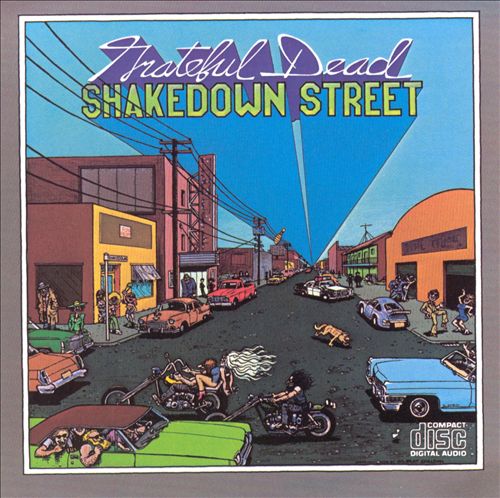
Grateful Dead – Shakedown Street (1978/2013)
FLAC (tracks) 24 bit/192 kHz | Time – 39:27 minutes | 1,56 GB
Official Digital Download – Source: HDTracks.com | Front cover
Since the Grateful Dead were notorious for recording awkward studio albums, it always seemed that the answer to their problem was simply getting the right producer to coax magic out of the band — and nobody would seem better suited for the position than Little Feat leader Lowell George, whose own band shared the Dead’s tendency to wander and jam in a live setting, yet made almost nothing but good studio records. But 1978 was not a great year for either camp, as the Dead were drifting in their attempts to score a crossover hit for Clive Davis’ Arista Records, while George was pushing Little Feat toward disbandment as he was inching closer to his premature death in 1979. Add to that the Dead’s sudden, inexplicable fascination with disco, a desire to have Donna Jean Godchaux be an integral part of the record, plus no new songs ready to go at the beginning of the sessions, and it’s little surprise that Shakedown Street wound up as a mess. It rambles and wanders all over the place, as the Dead cover the Rascals’ “Good Lovin’” before they revive “New Minglewood Blues” (which they originally cut for their debut), as Jerry Garcia and Robert Hunter write their own “Stagger Lee” while Mickey Hart and Bill Kreutzmann get a percussion workout on the brief instrumental “Serengetti” and Bob Weir affects a bluesy growl on “I Need a Miracle.” In George’s hands, this is all given a smooth gloss not all that far removed from such latter-day Feat LPs as The Last Record Album, but since the Dead favor hazy, lazy grooves to Feat’s laid-back but tight New Orleans funk — and since George didn’t produce so much as he created an appropriate atmosphere in the studio — Shakedown Street meanders mercilessly, and its indulgences wind up overwhelming the album as a whole. And there isn’t just one kind of indulgence here; there’s a plethora of them, ranging from the disco pulse of the title track to the fuzziness of the two songs sung by Donna Jean. This can make Shakedown Street a bit of a difficult, dated listen, since even the good songs boast bad arrangements (“Shakedown Street” and “Fire on the Mountain” were later reworked and revitalized in concert), yet it falls short of flat-out disaster, partially because it’s a fascinating listen due to the very things that make it a severely flawed record. The disco flirtations, subdued funk, misguided commercial concessions, and overarching Californian slickness do make Shakedown Street fascinating for at least one spin, even if they’ll keep even hardcore Deadheads — maybe especially hardcore Deadheads — from coming back to the record more than once every decade or so.
Tracklist:
01 – Good Lovin’
02 – France
03 – Shakedown Street
04 – Serengetti
05 – Fire On The Mountain
06 – I Need A Miracle
07 – From The Heart Of Me
08 – Stagger Lee
09 – All New Minglewood Blues
10 – If I Had The World To Give
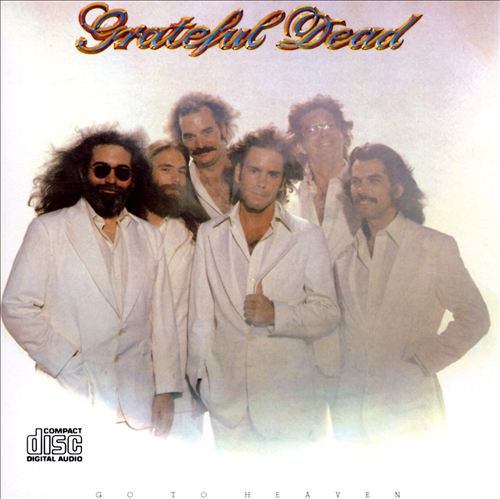
Grateful Dead – Go To Heaven (1980/2013)
FLAC (tracks) 24 bit/192 kHz | Time – 38:27 minutes | 1,58 GB
Official Digital Download – Source: HDTracks.com | Front cover
Time has somewhat mellowed the general disdain that critics and Deadheads alike leveled at Go to Heaven upon its release in May of 1980. Granted, none of these readings come close to their perfunctory live counterparts. However, that argument holds true for a vast majority of the Dead’s studio catalog — which had now grown to include 16 albums. Additionally, this disc marked the beginning of keyboardist Brent Mydland’s tenure — who had joined the band in the spring of the previous year and would remain for a decade. All eight of the songs — not including “Antwerp’s Placebo (The Plumber),” which is a 38-second instrumental percussion track — had either already worked their way into the Dead’s live performance repertoire, or would in due time. These include “Althea,” “Feel Like a Stranger,” and “Saint of Circumstance,” as well as the raucous rock & roll opening cut, “Alabama Getaway” — which was likewise often the band’s opening number in concert during the early ’80s. (In a somewhat Prankster-esque sense of irony, “Don’t Ease Me In” — the disc’s final number — also closed many a first set during this era; additionally notable about the track is that it was one of the first songs the band performed back in 1965 — when they were known as the Warlocks.) In terms of the quality of material, Go to Heaven includes few gems. Primary among them are Bob Weir’s “Lost Sailor” and “Saint of Circumstance” pairing. While obviously not as thoroughly developed as it would become in concert, the lilting melody and fluctuating tempos are reminiscent of his “Weather Report Suite” from the 1973 release Wake of the Flood. The groovin’ Jerry Garcia-sung ballad “Althea” is yet another example of a tune that would take on bolder and brighter hues as a concert staple for the remainder of the Dead’s performance life.
Tracklist:
01 – Alabama Getaway
02 – Far From Me
03 – Althea
04 – Feel Like A Stranger
05 – Lost Sailor
06 – Saint Of Circumstance
07 – Antwerp’s Placebo (The Plumber)
08 – Easy To Love You
09 – Don’t Ease Me In

Grateful Dead – In The Dark (1987/2013)
FLAC (tracks) 24 bit/192 kHz | Time – 40:54 minutes | 1,72 GB
Official Digital Download – Source: HDTracks.com | Front cover
The Grateful Dead’s last lineup returned intact for In the Dark, an album that ironically thrust the band back into the spotlight on the strength of the band’s lone Top 40 single, “Touch of Grey.” Fans had long mused that the Dead’s studio albums lacked the easygoing energy and natural flow of their live performances, and In the Dark does come close to capturing that lightning in a bottle. Jerry Garcia, who apparently had to relearn the guitar after a near-fatal illness, approaches his instrument recharged, while his voice (a beneficiary of the extended hiatus?) shows some of its original smoothness. Of his four songwriting collaborations with long-standing lyricist Robert Hunter, “Touch of Grey” is far and away the best. “When Push Comes to Shove” and “West L.A. Fadeaway” use familiar blues-based riffs that lack the pair’s often-contagious chemistry, and “Black Muddy River” has one foot firmly stuck in mawkish MOR terrain (although Garcia can be dealt a free pass here in light of the song’s real-life implications as an attempt to make his peace with the world). What pushes In the Dark past the band’s also-rans are two terrific songs from Bob Weir and John Barlow, the cheerfully cranky “Hell in a Bucket” (co-written with Brent Mydland) and the cautionary tale “Throwing Stones.” Rarely have Weir’s songs sounded so effortless; punctuated by Garcia’s guitar, they have more in common with the upbeat, flavorful sound of past Garcia/Hunter compositions than the pair’s own work this time out (a rare case of role reversal). In the middle of it all is a country-rock song from Mydland, “Tons of Steel,” that sounds oddly out of place. Although the album is unmistakable as the work of the Dead, much of it recalls the punchy, pungent production of Dire Straits’ recent work. It’s not the second coming of the Dead, but a more entertaining epilogue you couldn’t ask for.
Tracklist:
01 – Touch Of Grey
02 – Hell In A Bucket
03 – When Push Comes To Shove
04 – West L.A. Fadeaway
05 – Tons Of Steel
06 – Throwing Stones
07 – Black Muddy River
Please note: Track “1″ was digitally multi-tracked at 44,1 kHz
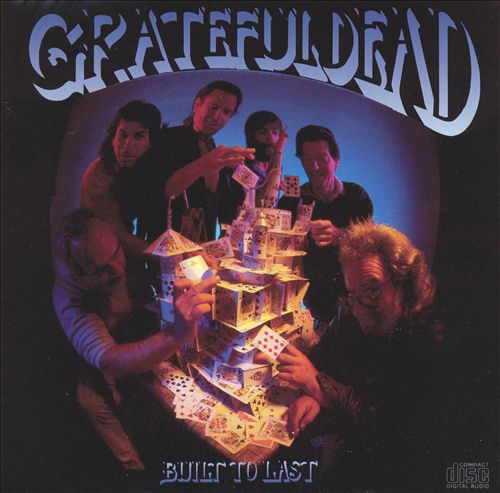
Grateful Dead – Built To Last (1989/2013)
FLAC (tracks) 16 bit/44,1 kHz | Time – 50:14 minutes | 337 MB
Official Digital Download – Source: HDTracks.com | Front cover
The Grateful Dead’s last lineup returned intact for In the Dark, an album that ironically thrust the band back into the spotlight on the strength of the band’s lone Top 40 single, “Touch of Grey.” Fans had long mused that the Dead’s studio albums lacked the easygoing energy and natural flow of their live performances, and In the Dark does come close to capturing that lightning in a bottle. Jerry Garcia, who apparently had to relearn the guitar after a near-fatal illness, approaches his instrument recharged, while his voice (a beneficiary of the extended hiatus?) shows some of its original smoothness. Of his four songwriting collaborations with long-standing lyricist Robert Hunter, “Touch of Grey” is far and away the best. “When Push Comes to Shove” and “West L.A. Fadeaway” use familiar blues-based riffs that lack the pair’s often-contagious chemistry, and “Black Muddy River” has one foot firmly stuck in mawkish MOR terrain (although Garcia can be dealt a free pass here in light of the song’s real-life implications as an attempt to make his peace with the world). What pushes In the Dark past the band’s also-rans are two terrific songs from Bob Weir and John Barlow, the cheerfully cranky “Hell in a Bucket” (co-written with Brent Mydland) and the cautionary tale “Throwing Stones.” Rarely have Weir’s songs sounded so effortless; punctuated by Garcia’s guitar, they have more in common with the upbeat, flavorful sound of past Garcia/Hunter compositions than the pair’s own work this time out (a rare case of role reversal). In the middle of it all is a country-rock song from Mydland, “Tons of Steel,” that sounds oddly out of place. Although the album is unmistakable as the work of the Dead, much of it recalls the punchy, pungent production of Dire Straits’ recent work. It’s not the second coming of the Dead, but a more entertaining epilogue you couldn’t ask for.
Tracklist:
01 – Foolish Heart
02 – Just A Little Light
03 – Built To Last
04 – Blow Away
05 – Victim Or The Crime
06 – We Can Run
07 – Standing On The Moon
08 – Picasso Moon
09 – I Will Take You Home
Please note: All tracks on this disc are in 44,1kHz/16bit
Download:
GD_Disc01TheGratefulDead1967.part1.rar
GD_Disc01TheGratefulDead1967.part2.rar
GD_Disc02AnthemOfTheSun1968.part1.rar
GD_Disc02AnthemOfTheSun1968.part2.rar
GD_Disc03Aoxomoxoa1969.part1.rar
GD_Disc03Aoxomoxoa1969.part2.rar
GD_Disc04WorkingmansDead1970.part1.rar
GD_Disc04WorkingmansDead1970.part2.rar
GD_Disc05AmericanBeauty1970.part1.rar
GD_Disc05AmericanBeauty1970.part2.rar
GD_Disc06WakeOfTheFlood1973.part1.rar
GD_Disc06WakeOfTheFlood1973.part2.rar
GD_Disc07FromTheMarsHotel1974.part1.rar
GD_Disc07FromTheMarsHotel1974.part2.rar
GD_Disc08BluesForAllah1975.part1.rar
GD_Disc08BluesForAllah1975.part2.rar
GD_Disc09TerrapinStation1977.part1.rar
GD_Disc09TerrapinStation1977.part2.rar
GD_Disc10ShakedownStreet1978.part1.rar
GD_Disc10ShakedownStreet1978.part2.rar
GD_Disc11GoToHeaven1980.part1.rar
GD_Disc11GoToHeaven1980.part2.rar
GD_Disc12InTheDark1987.part1.rar
GD_Disc12InTheDark1987.part2.rar
GD_Disc13BuiltToLast1989.rar




















![Grateful Dead - Spring 1990: The Other One (2014) [FLAC 24bit/96kHz] Grateful Dead - Spring 1990: The Other One (2014) [FLAC 24bit/96kHz]](https://getimg.link/images/imgimgimg/uploads/2021/07/BWFaVLj.jpg)
![Grateful Dead - Workingman’s Dead: The Angel’s Share (1970/2020) [FLAC 24bit/96kHz] Grateful Dead - Workingman’s Dead: The Angel’s Share (1970/2020) [FLAC 24bit/96kHz]](https://getimg.link/images/imgimgimg/uploads/2020/09/zgpYxh8.jpg)
![Grateful Dead - American Beauty - The Angel’s Share (Remastered) (1970/2020) [FLAC 24bit/96kHz] Grateful Dead - American Beauty - The Angel’s Share (Remastered) (1970/2020) [FLAC 24bit/96kHz]](https://getimg.link/images/imgimgimg/uploads/2020/12/fuF4Hfm.jpg)
![Whitesnake - Slip Of The Tongue (Super Deluxe Edition, Remaster) (2019) [FLAC 24bit/96kHz] Whitesnake - Slip Of The Tongue (Super Deluxe Edition, Remaster) (2019) [FLAC 24bit/96kHz]](https://getimg.link/images/imgimgimg/uploads/2019/11/4ssotXD.jpg)
![Grateful Dead - Wake of the Flood: The Angel's Share (2023) [FLAC 24bit/96kHz] Grateful Dead - Wake of the Flood: The Angel's Share (2023) [FLAC 24bit/96kHz]](https://imghd.xyz/images/2023/09/04/a9omh71ka1v5b_600.jpg)
![Grateful Dead - From the Mars Hotel (50th Anniversary Deluxe Edition) (1974/2024) [FLAC 24bit/192kHz] Grateful Dead - From the Mars Hotel (50th Anniversary Deluxe Edition) (1974/2024) [FLAC 24bit/192kHz]](https://imghd.xyz/images/2024/06/22/3a0266b5015f42569a5d12dfa4487575-8952719184219032077.webp)
![Grateful Dead - RFK Stadium, Washington, DC, 6/10/73 (Live) (2023) [FLAC 24bit/192kHz] Grateful Dead - RFK Stadium, Washington, DC, 6/10/73 (Live) (2023) [FLAC 24bit/192kHz]](https://imghd.xyz/images/2023/08/05/x7onj623tvu5a_600.jpg)
![Grateful Dead - American Beauty (50th Anniversary Deluxe Edition) (1970/2020) [FLAC 24bit/96kHz] Grateful Dead - American Beauty (50th Anniversary Deluxe Edition) (1970/2020) [FLAC 24bit/96kHz]](https://getimg.link/images/imgimgimg/uploads/2020/12/nkybijW.jpg)
![Grateful Dead - Fox Theatre, St. Louis, MO (12/10/71) (2021) [FLAC 24bit/192kHz] Grateful Dead - Fox Theatre, St. Louis, MO (12/10/71) (2021) [FLAC 24bit/192kHz]](https://getimg.link/images/imgimgimg/uploads/2021/12/HJPOPKC.jpg)
![Grateful Dead - Grateful Dead (Skull & Roses) [50th Anniversary Expanded Edition] (2021) [FLAC 24bit/192kHz] Grateful Dead - Grateful Dead (Skull & Roses) [50th Anniversary Expanded Edition] (2021) [FLAC 24bit/192kHz]](https://getimg.link/images/imgimgimg/uploads/2021/08/ibL4ne0.jpg)
![Yes - High Vibration: SACD Box (2013) [Japanese 16 Discs Box Set] {SACD ISO + FLAC 24bit/88,2kHz} Yes - High Vibration: SACD Box (2013) [Japanese 16 Discs Box Set] {SACD ISO + FLAC 24bit/88,2kHz}](https://getimg.link/images/imgimgimg/uploads/2016/11/XWHGviA.jpg)
![Grateful Dead - From the Mars Hotel: The Angel's Share (2024) [FLAC 24bit/96kHz] Grateful Dead - From the Mars Hotel: The Angel's Share (2024) [FLAC 24bit/96kHz]](https://imghd.xyz/images/2024/04/18/u5ilax0kpkn4a_600.jpg)
![Grateful Dead - Europe '72 (Live) (50th Anniversary Edition) (2022) [FLAC 24bit/192kHz] Grateful Dead - Europe '72 (Live) (50th Anniversary Edition) (2022) [FLAC 24bit/192kHz]](https://imghd.xyz/images/2022/10/02/ptpbgme3uifza_600.jpg)
![Grateful Dead - Madison Square Garden, New York, NY 3/9/81 (2022) [FLAC 24bit/192kHz] Grateful Dead - Madison Square Garden, New York, NY 3/9/81 (2022) [FLAC 24bit/192kHz]](https://imghd.xyz/images/2022/11/27/tkr0142egj8cb_600.jpg)
![Grateful Dead - Duke '78 (Live at Cameron Indoor Stadium, Duke University, Durham, NC, 4/12/78) (2024) [FLAC 24bit/192kHz] Grateful Dead - Duke '78 (Live at Cameron Indoor Stadium, Duke University, Durham, NC, 4/12/78) (2024) [FLAC 24bit/192kHz]](https://imghd.xyz/images/2024/09/20/tpd1plje1brpb_600.jpg)